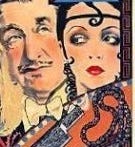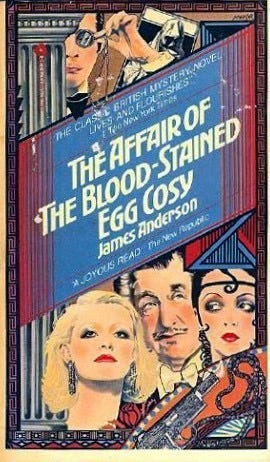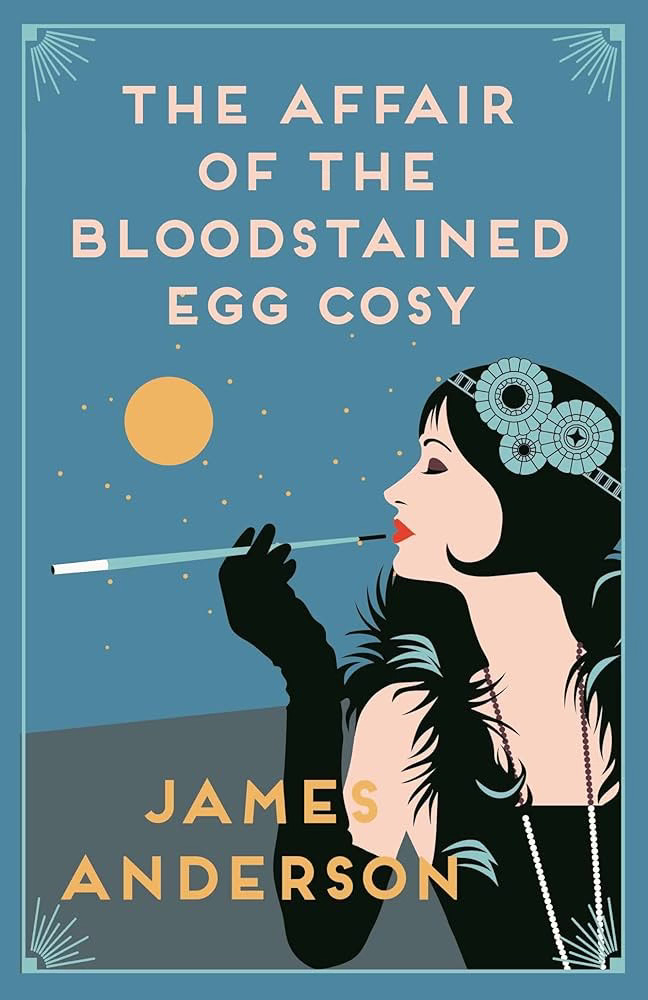The Affair of the Blood-Stained Egg Cosy by James Anderson
some thoughts on why we’re still reading golden age-style fiction
The Golden Age is a very specific (and yet oddly elastic) moment in mystery fiction history, roughly defined as between the two world wars and usually (again, so elastic!) taking place in the British countryside. As any casual reader knows, its rules are fairly rigid and well-defined, its character types limited, its settings restricted almost exclusively to the environs of the upper class. It’s an incredibly narrow scope for a genre that is still widely read and reinvented a century later.
Certainly there is much to criticize, particularly when it comes to economic and racial diversity. Even in the 1930s, the grand country estates with a full staff and a leisure class that was somehow more charming than insufferable was more myth than reality. Perhaps the secret to the genre’s success is that it was always built on nostalgia for a time that never really existed, even for the moneyed class. It’s not as though the bright young things of the 1930s were routinely chumming it up with Scotland Yard inspectors and larking about the countryside in search of clues to who murdered an old man that everyone secretly detested. It was always a fantasy.
Viewed in that light, its current resurgence makes a lot of sense. A world in which the rich and powerful are harmless fun instead of power-hungry despots? In which the working class (unrealistically content with their lot in life) are in fact, never the guilty party, nor are they used as scapegoats so the wealthy can get away with literal murder? The culprit is almost always a rich white guy (sometimes gal) and they’re actually punished in the end? Rich people killing each other off in inventive ways may not be reality, but it is a delightful escape.
So instead of simply playing out its two-ish decades of wild popularity before fading into the post-war gloom of the 1950s, the Golden Age has lived on, either spiritually, through contemporary stories that channel some of its tropes and rules (Everyone in My Family Has Killed Someone and West Heart Kill are two recent, excellent examples), or novels set in the Golden Age. There’s a high degree of difficulty in the second option; one must find a novel approach to a well-loved and well-trodden genre while writing a period piece, full of very strict social rules, stock characters and, if the writer is truly committed, fair play.
Hitting just the right stylistic note is challenging as well. Too many ‘by jove’ and ‘what ho’s’ and you sound like a P.G. Wodehouse parody, not enough and you sound too modern. Do your characters behave like they’re in a Golden Age novel (smoking and drinking: yes; sex and swearing: no) or do they act contemporarily in a period setting (yes to everything)? Do you wink at the audience or play it straight?
Falling somewhere in between on most of those questions is James Anderson’s delightful 1975 whodunnit, The Affair of the Blood-Stained Egg Cosy. It’s a love letter to the genre that playfully winks at its absurdities while reveling in them. My paperback edition quotes the San Francisco Chronicle as saying, “Packed as full as a good fruitcake, including the nuttiness… a Stately Home, with everyone simply whizzing around in the dark; murders, a jewel thief called The Wraith; charming young women, impersonations, a pair of antique pistols (priceless)… and a surprise finish.” Hard to argue with that summing up — this is the most overstuffed plot I’ve come across.
In brief, a comically large and varied group converges on Alderley, the home of the Earl of Buford, his wife and their daughter, for a house party. They include a Texas millionaire and his wife, the millionaire’s secretary, a pair of foreign dignitaries on top secret business, their British counterparts, a professional hanger-on, the impoverished friend of the family and an author writing a book about stately homes. Crashing the party — and evening out the number at dinner — is a suspicious foreign Countess (is there any other kind?). Nearly everyone is up to something, so when jewels go missing and bodies start piling up, everyone is under suspicion.
Anderson’s love of the genre is evident throughout — he affectionately plays up every trope, from the foreign femme fatale to the plucky ingenue and everything in between. Inspector Wilkins, tasked with uncovering myriad secrets as well as the identity of the killer, even has a catchphrase. He’s more Colombo than Poirot, shambling around like a clueless fool while claiming he’s “not sanguine, not sanguine at all.” In reality, of course, he sees through everyone’s considerable secrets and lies to uncover multiple truths: he unmasks an international jewel thief, solves two murders and discovers the truth behind the missing antique pistols.
Anderson never met a Golden Age trope he didn’t shoehorn into the overfull plot: a long and crucial sequence takes place at night during a storm, with almost every character sneaking about in the dark for a variety of reasons. Keeping track of who went where and why may help you keep up with Inspector Wilkins, but it hardly matters. The fun is in the journey, not the destination.
Further reading: This is the first in a trilogy set at the stately Alderley. It was followed by The Affair of the Mutilated Mink (1981) and The Affair of the Thirty-Nine Cufflinks (2003).







I read this trilogy probably about 12 years ago, and remember enjoying them. It will be interesting to revisit them, now that I've read more actual golden age detection